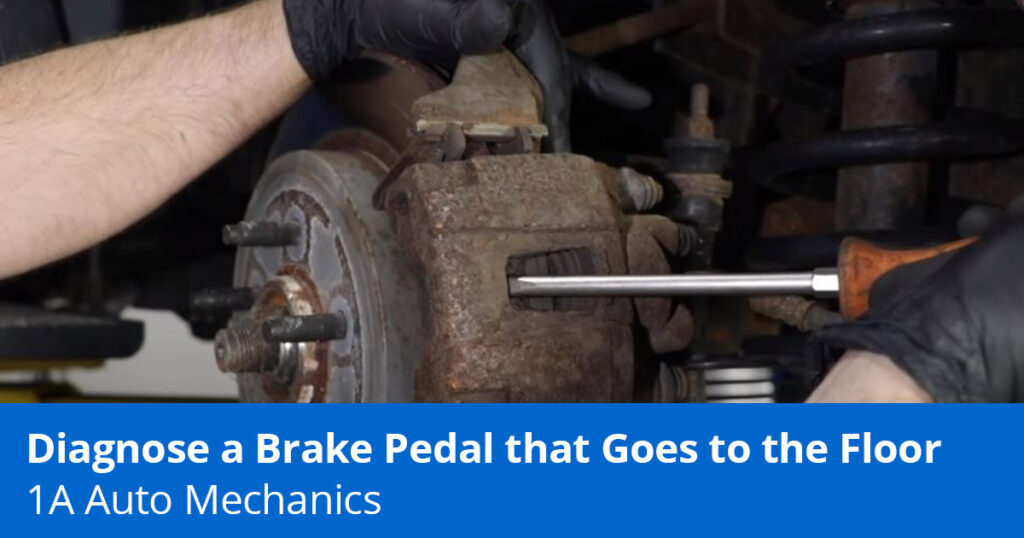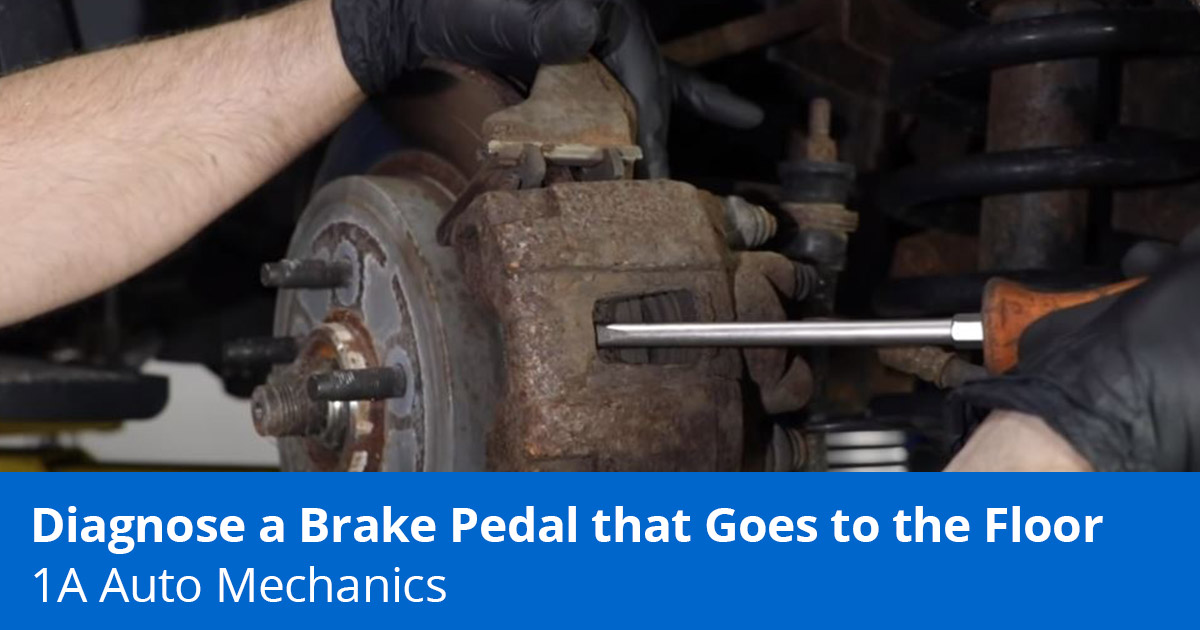
If your brake pedal goes to the floor or feels soft and spongy when depressed, brake system parts like the brake master cylinder, brake booster, brake lines, brake hoses, brake caliper, brake pads, or the brake rotor could be faulty. In this article and video, our experts review how to inspect the brake system to find out what’s causing a soft brake pedal and how to fix it.

How to Fix a Spongy or Soft Brake Pedal that Goes to the Floor
If you notice the brake pedal feels soft, spongy, or squishy and goes to the floor further than usual, these steps can help you find out why it’s happening.
Steps for Diagnosing and Fixing a Soft Brake Pedal That Goes to the Floor
- Check the Brake Fluid Level
Find the master cylinder and the brake fluid reservoir. Reservoirs on most vehicles will have a MAX and MIN line. Make sure the fluid in the brake fluid reservoir is between these marks. You may be able to shake the reservoir for a better view of the fluid and fluid level.
A low brake fluid level is a good indication of an issue with the brake system, but even if the level is not low, you still want to check the brake system for leaks.
- Check the Master Cylinder for Leaks
Look around the master cylinder and the brake hoses and brake lines for leaking brake fluid
- Check the Brake Lines and Hoses for Corrosion and Leaks
Go around the entire vehicle and check all the brake lines underneath it. Make sure none of them look corroded, rusty, or are leaking brake fluid.
Check the brake hoses. Make sure there is no brake fluid on the brake hoses. Brake fluid should not be seeping out of the brake lines.
- Check the Brake Caliper for Brake Fluid Leaks and Its Condition
Inspect the brake caliper and its components for brake fluid leaks. The parts should be dry from brake fluid. Make sure there is no fluid leaking on the brake caliper. If the brake caliper is soaked in brake fluid, that’s an obvious indicator it needs to be replaced, but sometimes the signs are not so obvious. Double check the dust boots for moisture. If you see moisture on the dust boot, the brake caliper needs to be replaced.
Slowly pry the brake caliper to the side with a flat blade screwdriver by pressing it against the side of the brake caliper. Make sure the brake caliper can slide back and forth, as demonstrated at 2:20 in the video above. This means the brake caliper slides are not frozen. If the caliper will not slide when pried to the side, like in the video above at 3:00, the brake caliper slides are frozen. You may be able to retrieve the slide out of the bracket, but often the bracket will need to be replaced. Also, check the brake caliper piston. Gently pry against the piston and make sure it can compress back into the caliper. If the piston will not compress, the brake caliper needs to be replaced.
- Check the Brake Pads Condition
Then check the brake pads. Make sure the brake pads are not frozen to the brake caliper bracket, which can cause the brake pedal to go the floor. If the brake pads are extremely thin, that can cause low brake fluid, and most of the fluid will be in the brake calipers.
- Check the Brake Rotor or Drum Brakes Condition
If the brake rotor has excessive rust, that’s because the brake pads are not making good contact with the brake rotor. Check both sides of the brake rotor. The front may look clean, but the back of the rotor may be rusty. If the brake rotor is rusty, the brake pads and brake rotor need to be replaced.
Also, if the rotor is rusty, make sure all parts on the caliper are working and that the caliper is sliding.
If you have rear drum brakes, you’ll need to remove the brake drums and inspect the wheel cylinder. Make sure the wheel cylinder is not leaking or it will need to be replaced. With the brake drums removed, check the length of the shim material on the brake shoes. If the brake shoes are worn, that can also cause a squishy brake pedal. Also, if the brake shoes are not adjusted properly, that can also cause a spongy brake pedal.
- Check the Brake Booster for Brake Fluid
If you didn’t find any leaks in the locations mentioned above, the master cylinder could be leaking brake fluid into the brake booster. The master cylinder or the vacuum hose will need to be removed from the brake booster. Slide a borescope or long zip tie or an object of similar length inside and see if there is brake fluid in the brake booster. If fluid is in the brake booster, the brake booster and master cylinder need to be replaced.

- If the Brake Fluid Is Low, Try Bleeding the Brakes
Air might be in the brake system if the brake fluid is low. Remove air from the brake system by bleeding the brakes.

- If the Parts Above Are in Good Condition, the Master Cylinder May Be Defective
If brake system parts show no signs of leaking or defectiveness, there could be an internal problem with the master cylinder. It might not be compressing the fluid correctly, which will give a spongy brake pedal feel. If the master cylinder is defective, replace it.

Diagnose and Replace Parts on Your Car
Learn how to diagnose and replace parts yourself with 1A Auto’s how-to videos. We have thousands of videos specific to many makes and models with step-by-step instructions from professional mechanics to help you diagnose and replace parts on your car.
Related Content
- Rear Drum Brakes Adjustment: How to Clean and Adjust Rear Drum Brakes
- How to Bleed Brakes By Yourself
- When Should Brake Pads Be Replaced?
- Frozen Brakes: Do You Smell Burnt Rubber or Plastic?
- TRQ brake parts buying guide: Save time and money with quality brake kits
- Recycling Waste Fluids and Oils? How to Dispose of Motor Oil, Antifreeze, Brake Fluid, and More
Shop Brake Parts and More
- Brakes & Wheel Bearing
- Brake Drums
- Brake Shoes
- Brake Hardware
- Brake Rotors
- Brake Pads
- Brake Kits
- Brake Hoses, Lines, and Fittings
- Brake Calipers & Brackets
- Brake Master Cylinder
- Drivetrain
- Tools & Accessories
- Inspection Tools

